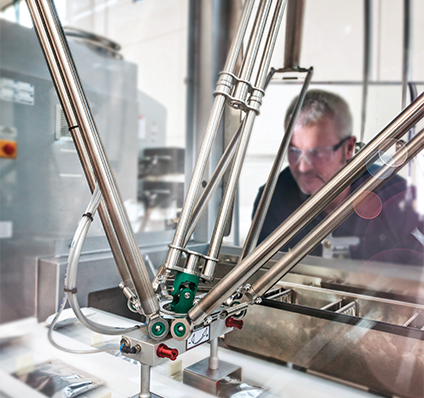
The next level
With the manufacturing industry under increasing pressure to deliver more at a lower cost, the coming years will see manufacturers take steps to create a completely ‘smart’ factory floor.
Thanks to recent advancements in technologies, most notably with the Industrial Internet of Things (IIoT), using smart technology is feasible for a greater number of manufacturers. However, a truly ‘smart factory’ is one that is completely digitized with a high level of automation and connectivity throughout its whole supply chain.
There is a significant increase in the demands for robots, and indeed cobots, as a result of rising wages and skill shortages. As automation developers introduce better sensing/vision capabilities, ever more complex applications can be tackled. More responsive safety systems will also allow cobots to work alongside humans with greater flexibility, improving productivity, hygiene and safety.
Robots are being used to carry out tasks previously performed by humans, but in just a fraction of the time. Robots are being applied to the food and beverage industry to assist in functions including; packing, handling, quality control and even maintenance.
The explosion of ‘cobotics’
Like many industrial processes, food and drink production is always at risk from human error, which can cause downtime, poor quality and product loss, ultimately increasing costs. To minimize these risks and protect the production line, we are seeing the introduction of ‘cobotics’ – compact, easy-to-use and collaborative robots to work alongside humans.
As automation developers introduce better sensing capability and more responsive safety systems, the application of robotic equipment in this space will only increase – paving the way for improved interaction so that complex processes can be completed faster, more easily and more safely.
With this change comes an additional benefit for a skills-poor industry struggling to attract engineering expertise. The cobotics movement doesn’t replace humans, rather it simply frees up highly skilled workers time for more value-add activity.
Minimizing the risks
We are beginning to see how this collaboration can minimize risks to employees working on the factory floor. Robots are able to perform more dangerous and repetitive jobs that can often be hazardous for humans, such cutting and slicing. In turn, this allows workers to apply their skills elsewhere. It also eases the social implications of the trend, ensuring the two parties can work in harmony towards productivity goals, while tackling the problem of engineering expertise retiring out of the workforce.
With increasingly sophisticated sensors and more highly functional robotic equipment, the collaboration between humans and machines on the factory floor is imperative to ensure uniformity and efficiency. This is because robots not only reduce the chances of human error, but also because they manage resources to achieve the best margin. For example, food manufacturers such as bakers have started to notice increased productivity and quality as a result of incorporating smart technologies into their equipment. Connecting these devices has shown it is possible to control speed, precision and the volume of ingredients, combining high turnover with consistent quality.
The journey to success
For food manufacturers to ensure that they are getting the most out of their food lines, it’s important that they implement robotics and analytics. Ultimately, the only way to protect the food line from human error or equipment failure is to gather a greater insight into processes – with the capability to react in real-time. If we are to progress and take manufacturing to the next level, incorporating robotics into the production line is a vital part of this and the health and longevity of the sector relies on it.
For the ‘robotics and cobotics’ movement to thrive, we must educate our workforce on its benefits and capabilities. With greater understanding, will come greater implementation and proficiency. Over the next ten years, we expect to see it proliferate and manufacturers to reap the benefits of greater efficiency, profitability and performance. At the same time, any manufacturing operations that do not adopt digital technologies will get mar ginalized – if not lost. Ultimately, legacy/non-connected technologies do not fit into the digital ecosystem, where analysis and optimization are fundamental.
We are set to see more manufacturers recognize the true benefits of smart manufacturing. In the meantime, increased data insights and connectivity will lay solid foundations for new, and more effective business models.
Mark Yeeles
 Mark Yeeles is Vice President of Industrial Automation at Schneider Electric. Schneider’s purpose is to empower all to make the most of our energy and resources, bridging progress and sustainability for all. We call this Life Is On. Our mission is to be your digital partner for Sustainability and Efficiency.
Mark Yeeles is Vice President of Industrial Automation at Schneider Electric. Schneider’s purpose is to empower all to make the most of our energy and resources, bridging progress and sustainability for all. We call this Life Is On. Our mission is to be your digital partner for Sustainability and Efficiency.
We drive digital transformation by integrating world-leading process and energy technologies, end-point to cloud connecting products, controls, software and services, across the entire lifecycle, enabling integrated company management, for homes, buildings, data centers, infrastructure and industries.
www.se.com